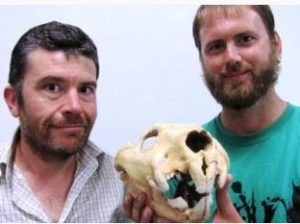
Flinders University palaeontologists have cast new light on the behaviour of Australia’s fearsome marsupial lion (Thylacoleo carnifex) – one of the most unique meat-eating mammals ever to have lived.
Most closely related to plant-eaters like possums and wombats, the T. carnifex was Australia’s top mammalian predator, weighing up to 100kg, with powerful jaws and large, sharp claws. It became extinct around 40,000 years ago, soon after the arrival of humans.
In a new paper published this week in Nature’s Scientific Reports, Flinders researchers Sam Arman and Gavin Prideaux show that marsupial lions were responsible for leaving thousands of claw marks on surfaces inside a limestone cave in south-western Australia.
Using a novel analysis of the marks, the Flinders scientists uncovered two key aspects of marsupial lion biology: they were excellent climbers and reared young in caves.
Combined with its robust build and meat-slicing teeth, the new evidence points toward T. carnifex as a stocky-yet-agile predator, a formidable threat to megafaunal herbivores, such as giant short-faced kangaroos … and humans, with T. carnifex evocatively portrayed in Aboriginal rock art from northern Western Australia.
Despite being the subject of numerous skeletal studies, the habits and life history of T. carnifex have remained largely unknown.
The Flinders researchers focused on the claw-mark assemblage because it allowed them to test ideas about the animal previously advanced on the basis of skeletal anatomy.
“Could marsupial lions climb trees and leap onto unsuspecting prey? Were they solitary or social? Did adults leave young behind in dens when they went off to feed like other carnivores such as Tasmanian devils and hyaenas?” asks Associate Professor Prideaux.
“We cannot travel back in time to answer these questions and one can only deduce so much from fossil skeletons.”
Thousands of claw marks were analysed along with a rich Pleistocene bone deposit in the aptly-named Tight Entrance Cave near Margaret River in WA.
“The largest of the scratch marks could only have been made by adults of T. carnifex. Many of the smaller marks were made by juveniles: they have the same form as that of the adults, but do not match claw marks made by other known cave dwellers,” the researchers say.
“Marsupial lions, like all marsupials, would have given birth to extremely underdeveloped young that could not be left alone until becoming at least partially weaned.
“Caves would have provided them with a safe, climate-controlled environment for raising young that was defensible against other carnivores such as thylacines and devils.
“Given that marsupial lions were apparently adapted to apprehending and consuming large prey, it is feasible that they hunted cooperatively.”
Such a strategy may have been what allowed them to prey upon the largest marsupial of its time, the rhinoceros-sized Diprotodon optatum, bones of which have been found previously with T. carnifex bite marks.
Many of the Tight Entrance Cave claw marks were located on very steep surfaces up to 3 metres from the cave floor, probably because this was the quickest route to the exit hole in the cave roof.
“They could have chosen longer routes to the exit with gentler slopes, but the distribution of claw marks shows that, habitually, they did not. Clearly they were excellent climbers and would easily have been able to climb trees”, says Mr Arman, the paper’s lead author.
The research, supported by funding from the Australian Research Council Discovery grant, was assisted by other palaeontologists at Flinders’ School of Biological Sciences, the SA Museum, TAFE SA and the Princess Margaret Hospital.

